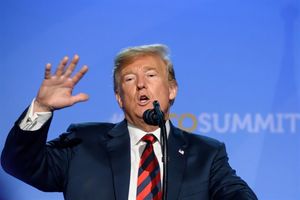
BUSAN, South Korea – In a development poised to send ripples across global financial markets, US President Donald Trump and Chinese President Xi Jinping today announced a significant trade truce on the sidelines of the Asia-Pacific Economic Cooperation (APEC) Summit. The agreement, coming after months of escalating tensions and tariff battles, has been met with a mix of cautious optimism and palpable relief by investors worldwide. While the immediate reaction saw a surge in market sentiment, analysts are quick to point out that this is likely a tactical pause rather than a complete resolution of the underlying, complex trade disputes between the world's two largest economies.
The truce, struck today, October 30, 2025, aims to de-escalate the trade war that has cast a long shadow over global growth prospects. Key components include a reduction of US tariffs on Chinese goods and China's commitment to resume purchases of US agricultural products. This breakthrough offers a much-needed reprieve for multinational corporations and provides a glimmer of hope for stability in supply chains, though the long-term implications and the durability of this agreement remain subject to intense scrutiny.
A Glimmer of Hope Amidst Lingering Tensions
The high-stakes meeting between President Trump and President Xi today, October 30, 2025, in Busan, South Korea, culminated in an agreement to de-escalate the ongoing trade conflict. The core of the truce involves the US reducing its tariffs on Chinese goods from 57% to 47%, a significant rollback, in exchange for concrete commitments from China. These commitments reportedly include the resumption of purchases of US soybeans and other agricultural products, a move eagerly anticipated by the American farming sector. Furthermore, China has agreed to delay its rare earth export curbs by one year and committed to a crackdown on the illicit trade of fentanyl. In a reciprocal gesture, the US has also agreed to a one-year suspension of Entity List restrictions on several Chinese firms, providing a lifeline to technology companies caught in the crossfire.
The path to this truce has been fraught with challenges, marked by a series of tit-for-tat tariff impositions that began years prior. The timeline leading up to today's meeting saw numerous rounds of negotiations, often ending in stalemates, punctuated by periods of heightened rhetoric and market volatility. Key players involved have consistently been the US Trade Representative's office and China's Ministry of Commerce, with Presidents Trump and Xi ultimately serving as the principal decision-makers. The initial market reaction to the news has been mixed but generally positive. Chinese stock markets, after an initial climb, saw a slight pullback, suggesting a "buy the rumor, sell the news" effect, or perhaps a sober realization that deeper issues persist. Globally, however, broader stock markets have generally risen on the back of the optimism for an extended trade truce, with currencies like the Australian and New Zealand dollars seeing gains, while China's renminbi retreated slightly from a near one-year high against the US dollar.
Initial sentiment among investors and analysts is one of cautious optimism. Many view this as a tactical pause that buys both sides breathing room, rather than a fundamental resolution of the structural issues underpinning the trade dispute. While President Trump lauded the meeting as "amazing" and "highly productive," Chinese officials offered a more measured tone, indicating that preliminary consensus had been reached and required internal review. This divergence in rhetoric underscores the delicate nature of the agreement and the potential for future disagreements, keeping market participants on edge for further details, especially from Beijing.
Corporate Fortunes in the Balance: Winners and Losers
The newly announced US-China trade truce is expected to create a significant shift in corporate fortunes, directly impacting various sectors and individual companies. The immediate beneficiaries are likely to be US agricultural producers, particularly those involved in soybean and other crop exports, who have borne the brunt of retaliatory Chinese tariffs. Companies like Archer-Daniels-Midland (NYSE: ADM) and Bunge Limited (NYSE: BG), major players in agricultural commodities, could see increased demand and improved pricing power, leading to stronger earnings. Similarly, US semiconductor companies and other tech firms that were placed on the Entity List, such as Huawei Technologies Co. Ltd., stand to gain from the one-year suspension of restrictions, allowing them to resume sourcing critical components and alleviate supply chain disruptions. This could provide a boost to their stock performance and operational stability.
Conversely, some sectors might face renewed competitive pressures. While the overall sentiment is positive, the reduction in US tariffs on Chinese goods could intensify competition for certain domestic manufacturers in the US. Companies that benefited from the previous tariff regime by having their Chinese competitors face higher import costs might now see those advantages diminish. Furthermore, the truce's focus on specific sectors means that companies outside these immediate areas of agreement might not see significant uplift and could continue to navigate broader economic uncertainties. The rare earth industry in China, while seeing a temporary delay in export curbs, will still face the underlying strategic competition from the US and other nations seeking to diversify their supply chains away from Chinese dominance.
The long-term impact on companies will largely depend on the durability of this truce and whether it evolves into a more comprehensive trade agreement. For multinational corporations with extensive operations and supply chains in both countries, such as Apple Inc. (NASDAQ: AAPL) or General Motors Company (NYSE: GM), the truce offers a period of stability, potentially reducing manufacturing costs and improving market access. However, the underlying technological rivalry, particularly in areas like 5G and artificial intelligence, remains a key concern. Companies heavily invested in these strategic sectors, both in the US and China, will continue to face scrutiny and potential policy shifts, irrespective of the current tariff agreement. Investors should closely monitor the implementation of the truce and any subsequent negotiations to identify sustained winners and potential new challenges.
A Broader Economic Rebalancing Act
The US-China trade truce, while a significant event in itself, fits into a much broader narrative of global economic rebalancing and geopolitical competition. This truce can be seen as a tactical de-escalation within an overarching trend of strategic rivalry between the two superpowers, encompassing not just trade but also technology, intellectual property, and regional influence. The move offers a temporary pause, allowing both nations to recalibrate their strategies, but it does not fundamentally alter the trajectory towards a more bifurcated global economy, where supply chains are increasingly regionalized and technological ecosystems are decoupled.
The potential ripple effects on competitors and partners are substantial. For instance, countries in Southeast Asia that have benefited from supply chain diversification away from China due to the trade war might see some of that momentum slow if stability returns to US-China trade. Conversely, allies of the US and China might feel pressure to align their own trade policies more closely with one or the other, further complicating global trade dynamics. Regulatory and policy implications are also profound; the agreement to suspend Entity List restrictions on Chinese firms, even temporarily, signals a willingness by the US to use such measures as bargaining chips, rather than purely security-driven actions. This could set a precedent for future negotiations and the use of economic tools in geopolitical disputes.
Historically, trade truces have often served as temporary reprieves rather than definitive resolutions to deep-seated economic rivalries. Comparisons can be drawn to various historical trade disputes where initial agreements only paved the way for more complex negotiations or renewed tensions later on. The current truce, therefore, should be viewed through the lens of ongoing competition, where both sides are seeking to maximize their strategic advantage while avoiding an all-out economic war. The long-term trend of China's economic rise and its integration into the global economy, coupled with the US's efforts to maintain its technological and economic leadership, will continue to shape the international trade landscape, making this truce merely one chapter in a much larger story.
Navigating the Path Ahead: Opportunities and Challenges
Looking ahead, the US-China trade truce opens up a range of short-term and long-term possibilities, but also presents new challenges and requires strategic adaptations from businesses and policymakers alike. In the short term, markets are likely to experience a relief rally, with increased investor confidence translating into higher valuations for companies previously impacted by trade uncertainty. Businesses can now plan with greater certainty, potentially accelerating investment decisions that were previously on hold. However, the temporary nature of some agreements, such as the one-year suspension of Entity List restrictions, means that companies like Huawei Technologies Co. Ltd. will need to use this window to diversify their supply chains and reduce reliance on components that could again be subject to restrictions.
In the long term, the truce could either serve as a foundation for more comprehensive trade agreements or simply defer deeper conflicts. The potential strategic pivots required for companies include further diversification of manufacturing bases outside of China, a trend already underway, and increased investment in R&D to maintain technological leadership irrespective of trade policy. Market opportunities may emerge in sectors that benefit from renewed bilateral trade, such as agriculture and certain industrial goods. Conversely, challenges will persist in high-tech sectors where the underlying competition for technological supremacy remains fierce, potentially leading to continued restrictions or national security-driven policies.
Potential scenarios range from a gradual, sustained de-escalation of trade tensions leading to a more normalized trading relationship, to a cyclical pattern of truces and renewed disputes. Investors should closely watch for concrete actions from both governments to implement the terms of the truce, as well as any rhetoric that might signal a shift in commitment. The development of a robust enforcement mechanism for the agreement will be crucial in determining its lasting impact. Companies that can adapt quickly to evolving trade policies and geopolitical realities will be best positioned to navigate this complex environment and capitalize on emerging opportunities.
A Fragile Peace: Assessing the Market's Next Steps
The US-China trade truce, announced today, October 30, 2025, represents a critical pause in a tumultuous period of global trade relations. The key takeaway is that while the immediate threat of escalating tariffs has been averted, and a sense of cautious optimism has permeated financial markets, the fundamental issues driving the US-China economic rivalry remain largely unresolved. This agreement should be viewed as a temporary de-escalation, providing much-needed breathing room for businesses and investors, rather than a definitive end to the trade war. The market moving forward will likely operate under a cloud of uncertainty regarding the longevity and depth of this truce.
For investors, the immediate assessment points to a likely continuation of the "relief rally" observed in global stock markets. Sectors such as agriculture, certain technology firms, and multinational corporations with significant exposure to both markets are poised for short-term gains. However, this period of calm should be utilized to assess long-term strategies, as the underlying competition for technological dominance and economic influence will persist. The truce underscores the importance of supply chain resilience and geographical diversification for businesses operating in a world increasingly shaped by geopolitical considerations.
In the coming months, investors should watch for several key indicators. Firstly, the concrete implementation of the agreed-upon terms, particularly China's agricultural purchases and the US's tariff reductions. Secondly, any further dialogue or negotiations between Washington and Beijing that could signal progress towards a more comprehensive trade deal. Thirdly, statements from both leaderships regarding the future trajectory of their economic relationship, as rhetoric often precedes policy shifts. Finally, the performance of key economic indicators in both countries will offer insights into the real-world impact of the truce. While today's announcement offers a welcome respite, the journey towards stable US-China trade relations is far from over, and vigilance remains paramount for navigating the evolving global market landscape.
This content is intended for informational purposes only and is not financial advice






